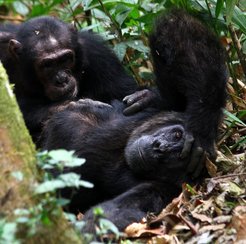The benefits of social grooming
Researchers found that in chimpanzees the hormone oxytocin is likely to play a key role in maintaining social relations with both kin and non-kin cooperation partners
Animals which maintain cooperative relationships show gains in longevity and offspring survival. However, little is known about the cognitive or hormonal mechanisms involved in cooperation. Researchers of the Max Planck Institute for Evolutionary Anthropology in Leipzig, Germany, have now found that cooperative relationships are facilitated by an endocrinological mechanism involving the hormone oxytocin, even when these are between non-kin. They collected urine samples of 33 chimpanzees from Budongo Forest, Uganda, and measured their urinary oxytocin levels after single episodes of a specific cooperative behaviour, mutual grooming. The result: Oxytocin levels were higher after grooming with cooperation partners compared with non-cooperation partners or after no grooming, regardless of genetic relatedness or sexual interest. This suggests that in chimpanzees oxytocin, which acts directly on neural reward and social memory systems, plays a key role maintaining social relations beyond genetic ties and in keeping track of social interactions with multiple individuals over time.

In non-human primates and other social animals strong and enduring social bonds are typically seen between genetically related individuals but also, occasionally, between non-kin, same-sex individuals. Although such relationships are typically defined by high rates of cooperative behaviours, how they are maintained over time is still unclear. In humans and other social mammals the neuropeptide hormone oxytocin plays a central role in facilitating bonding between kin and mating partners. Catherine Crockford, Roman Wittig and colleagues of the Max Planck Institute for Evolutionary Anthropology have now analysed the role of this hormone in the social relationships between wild chimpanzees.
To this end the researchers observed social interactions – like mutual grooming – in a group of wild chimpanzees from Budongo Forest in Uganda and non-invasively collected urine samples of the 33 female and male adult group members on plastic bags or leaves. They determined the level of the hormone oxytocin before and shortly after the animals had been grooming with each other and found that oxytocin levels were especially high in chimpanzees who had been grooming with a “bond partner”, a cooperation partner, irrespective of whether this bond partner happened to be their kin or not. On the other hand, the level of urinary oxytocin was much lower in chimpanzees who had been grooming with a “non-bond partner”, with whom they did not share a cooperative relationship, or in animals who had not been grooming at all. Furthermore, the researchers found that the animal’s sex or age, grooming duration and other factors did not have a significant influence on urinary oxytocin levels.
“Our results demonstrate that a rise in oxytocin was dependent upon the combined effects of social grooming with a bond partner”, says Catherine Crockford of the Max Planck Institute for Evolutionary Anthropology in Leipzig, Germany. “Crucially, oxytocin levels were similarly high after grooming with non-kin and kin bond partners. This suggests that, in chimpanzees, oxytocin plays a key role in maintaining social relations beyond immediate genetic ties”.
“This is the first study that measures the levels of the hormone oxytocin on wild animals in a non-invasive way”, says Roman Wittig of the Max Planck Institute for Evolutionary Anthropology. “We have developed a tool with which cross-species comparisons that link underlying physiology and behaviour can eventually be made of social mammals in their natural environment”. In future field research this tool will be used to compare single behaviours – like other cooperative or aggressive behaviours – by measuring how they differ from each other hormonally.
SJ/RW/HR












